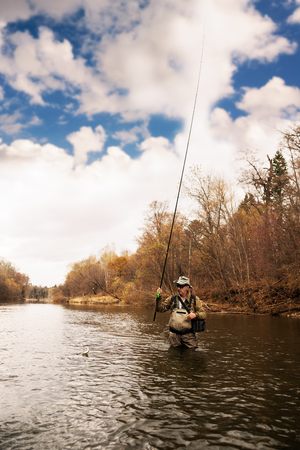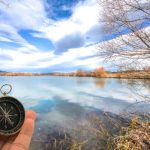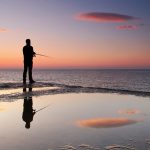1. The Rise of Fly Fishing in American Cinema
Fly fishing has long been a beloved outdoor activity in the United States, but it wasn’t until Hollywood brought it to the big screen that it truly captured the imagination of mainstream America. One of the most influential films in this transformation was A River Runs Through It, released in 1992 and directed by Robert Redford. Based on the semi-autobiographical novella by Norman Maclean, the film not only showcased the beauty of fly fishing but also highlighted its deeper, almost spiritual significance.
This film told the story of two brothers growing up in early 20th-century Montana, with fly fishing serving as both a bonding activity and a metaphor for life’s struggles and grace. Thanks to sweeping cinematography, poetic narration, and Brad Pitt’s breakout performance, A River Runs Through It struck a chord with audiences far beyond the traditional angling community. After its release, fly fishing saw a surge in popularity across the U.S., with many outdoor retailers and guides noting a spike in interest.
How Movies Influenced Fly Fishing Popularity
Movies didn’t just entertain—they shaped how Americans viewed fly fishing. The film helped position fly fishing not just as a hobby but as an expression of art, patience, and connection to nature. This sparked more people to explore rivers and streams with rods in hand, seeking the same sense of peace portrayed on screen.
Impact of “A River Runs Through It” on American Culture
| Aspect | Impact |
|---|---|
| Fly Fishing Participation | Significant increase in new anglers after 1992 |
| Outdoor Retail Sales | Boost in sales of fly rods, reels, waders, and books |
| Tourism | Growth in fly fishing tourism to states like Montana and Colorado |
| Cultural Perception | Fly fishing became associated with mindfulness and heritage |
The Legacy Continues
The influence of this film continues today, as new generations discover fly fishing through streaming platforms or family traditions. Other films have followed—some documentary-style, others fictional—but none have matched the cultural shift sparked by A River Runs Through It. It remains a landmark moment when cinema met nature and gave rise to an enduring piece of American outdoor culture.
2. Literary Foundations: The Influence of Early American Fly Fishing Writers
Fly fishing in America isnt just a sport—its a way of life, and that lifestyle has been deeply shaped by the written word. Long before fly fishing films became popular, books and essays played a key role in building the culture we know today. Two names stand out when we talk about the literary roots of American fly fishing: John Gierach and Ernest Schwiebert.
John Gierach: Everyday Wisdom on the Water
John Gierach is perhaps the most beloved voice in modern American fly fishing literature. His writing is down-to-earth, humorous, and filled with practical knowledge. Gierach has a knack for turning a simple day on the river into a story full of insight and philosophy. His essays explore not only how to fish but why we fish at all. Books like “Trout Bum” and “Even Brook Trout Get the Blues” have become must-reads for fly anglers across generations.
Key Themes in Gierach’s Writing:
| Theme | Description |
|---|---|
| Philosophy of Fly Fishing | Explores deeper meanings behind the sport and its connection to life. |
| Simplicity & Minimalism | Emphasizes enjoying fly fishing without overcomplicating gear or techniques. |
| Everyday Adventures | Tells stories from everyday fishing trips with humor and heart. |
Ernest Schwiebert: The Scholar of Fly Fishing
If Gierach is the storyteller, Ernest Schwiebert is the historian and technician. His works brought a scientific and artistic approach to fly fishing. Books like “Matching the Hatch” and the two-volume set “Trout” are rich with information about entomology, water ecosystems, and fly design. Schwiebert wrote with elegance, blending deep technical knowledge with poetic descriptions of rivers and trout behavior.
Schwiebert’s Contributions:
| Area | Impact |
|---|---|
| Scientific Understanding | Brought detailed knowledge of aquatic insects to mainstream anglers. |
| Aesthetic Appreciation | Taught readers to see beauty in both nature and fly patterns. |
| Cultural Legacy | Helped define American fly fishing as both art and science. |
A Lasting Influence
The works of Gierach and Schwiebert laid a strong literary foundation for American fly fishing culture. While their styles were different—Gierach more conversational, Schwiebert more scholarly—they both captured what it means to be an angler in America. Their books continue to inspire new generations, shaping not just how we fish, but how we think about fishing itself.
![]()
3. Cultural Icons and Their Impact
Fly fishing in America isn’t just a sport—it’s part of the nation’s cultural fabric, thanks in large part to influential figures who embraced it and helped define its image. Over the decades, celebrities, authors, and public figures have elevated fly fishing from a niche pastime to a symbol of rugged individualism and environmental consciousness.
Hollywoods Role in Romanticizing Fly Fishing
Movies have played a big role in shaping the American perception of fly fishing. One of the most iconic examples is A River Runs Through It (1992), directed by Robert Redford and starring Brad Pitt. The film not only showcased the beauty of Montana’s rivers but also portrayed fly fishing as a soulful, almost spiritual activity that connects people to nature and family. This movie sparked a huge surge in interest in fly fishing across the United States.
Celebrity Endorsements and Personal Passions
Several well-known American figures have publicly shared their love for fly fishing, helping to make it more mainstream. These individuals often highlight how the sport allows them to disconnect from busy lives and reconnect with nature. Here are some notable names:
| Celebrity | Profession | Impact on Fly Fishing Culture |
|---|---|---|
| Jimmy Carter | Former U.S. President | Used his platform to advocate for conservation through fly fishing; helped popularize catch-and-release ethics. |
| Ted Turner | Media Mogul & Conservationist | Promoted land conservation alongside fly fishing; owns large tracts of land used for sustainable outdoor recreation. |
| Tom Brokaw | Journalist & Author | Often featured fly fishing in his writing; tied it to themes of solitude and American tradition. |
The Writers Influence: Literature as Legacy
Apart from movies, literature has deeply influenced how Americans view fly fishing. Writers like Norman Maclean, author of A River Runs Through It, captured the poetic essence of the sport. His work did more than tell a story—it inspired readers to see fly fishing as a metaphor for life, struggle, and connection with nature. Other writers like John Gierach have continued this tradition by mixing humor, philosophy, and personal stories into essays that celebrate the everyday joys of casting a line.
Key Literary Figures in American Fly Fishing Culture
- Norman Maclean: Blended storytelling with fly fishing philosophy.
- John Gierach: Known for his witty essays that turn simple trips into meaningful reflections.
- Zane Grey: Adventure novelist who helped romanticize the outdoors and sport fishing during the early 20th century.
A Lifestyle Beyond Sport
Thanks to these cultural icons—on screen, on paper, and in real life—fly fishing has become more than just catching fish. It’s a lifestyle choice that represents self-reliance, mindfulness, and care for the natural world. Their influence continues to inspire new generations to take up the rod not just for sport, but for what it represents: freedom, reflection, and respect for nature.
4. Documentaries and Modern Media
In recent years, fly fishing has found new life through documentaries and digital platforms that have helped shape and modernize the sport for a broader, younger audience. These media outlets have not only preserved the rich history of fly fishing in America but have also reimagined its image in a way that resonates with today’s anglers.
The Power of Storytelling in Documentaries
Documentaries like A River Between Us, The River Why, and Eastern Rises have played a major role in showcasing fly fishing as more than just a hobby—it’s a lifestyle, an art form, and often a spiritual journey. These films highlight the beauty of nature, the bond between anglers, and the cultural significance of rivers across America. They also touch on important environmental issues, such as conservation and river restoration, which are deeply connected to the fly fishing community.
Digital Platforms Bringing Fly Fishing to the Masses
With YouTube, Instagram, and streaming services like Netflix and Amazon Prime, fly fishing content is now more accessible than ever before. Influencers, filmmakers, and everyday anglers share their adventures online, inspiring millions around the world to pick up a fly rod for the first time. Podcasts like The Orvis Fly Fishing Podcast and online communities such as Reddits r/flyfishing provide education, entertainment, and support for anglers at every level.
Popular Digital Channels & Their Impact
| Platform | Content Type | Impact on Fly Fishing Culture |
|---|---|---|
| YouTube (e.g., WildFly Productions) | Short films, tutorials, adventure vlogs | Makes fly fishing relatable & exciting for younger audiences |
| Instagram (@tightloopsfly) | Photography, short reels | Showcases lifestyle & aesthetics of modern fly fishing |
| Podcasts (The Orvis Fly Fishing Podcast) | Interviews, tips, conservation topics | Keeps community informed & connected year-round |
A New Generation of Anglers
This shift in media consumption has brought fresh energy into the sport. Younger anglers are drawn to the visual storytelling and authenticity found in these platforms. Theyre not just learning how to cast—theyre learning about river ecosystems, gear innovation, travel opportunities, and diverse voices within the fly fishing world. As a result, fly fishing is no longer seen as just an old-fashioned pastime; it’s evolving into something dynamic and inclusive.
5. The Role of Storytelling in Fly Fishing Heritage
Storytelling has always played a major role in shaping the culture of fly fishing in America. Whether its the pages of a classic novel or the frame of a well-loved film, stories help preserve the heart and soul of this beloved sport. More than just entertainment, these stories pass down wisdom, technique, and an emotional connection to nature that goes beyond the cast of a line.
Why Storytelling Matters
In fly fishing, every angler has a story—about the one that got away, the peaceful river at dawn, or the first fish caught on a hand-tied fly. These tales are more than memories; they become shared experiences that build community and tradition. Books and films act like time capsules, capturing moments that reflect both personal growth and cultural shifts within the sport.
Books That Shaped American Fly Fishing Culture
Some books have left a lasting impression on generations of anglers. They dont just teach techniques—they explore the spiritual side of fly fishing and connect readers to landscapes and traditions that define the American experience.
| Title | Author | Impact on Culture |
|---|---|---|
| A River Runs Through It | Norman Maclean | Blended family, faith, and fishing into a poetic narrative that introduced many to fly fishing’s deeper meaning. |
| The Longest Silence | Thomas McGuane | A thoughtful collection of essays that explores fly fishing as an art form and lifestyle. |
| Trout Bum | John Gierach | Brought humor and authenticity to modern fly fishing literature, inspiring everyday anglers. |
Films That Brought Stories to Life
Movies have played a key role in popularizing fly fishing across America. They visualize what books describe—making it easier for new audiences to feel connected to the sports values and beauty.
| Film Title | Release Year | Cultural Significance |
|---|---|---|
| A River Runs Through It | 1992 | This film adaptation brought fly fishing into mainstream culture with its stunning visuals and emotional storytelling. |
| The River Why | 2010 | An introspective look at self-discovery through fishing, appealing to younger generations. |
The Legacy Continues
As new writers and filmmakers emerge, they continue to add layers to this rich heritage. Their work ensures that fly fishing is not just about catching fish—its about understanding life, nature, and our place within it. Through storytelling, both past and present, we keep the spirit of American fly fishing alive for future generations.


